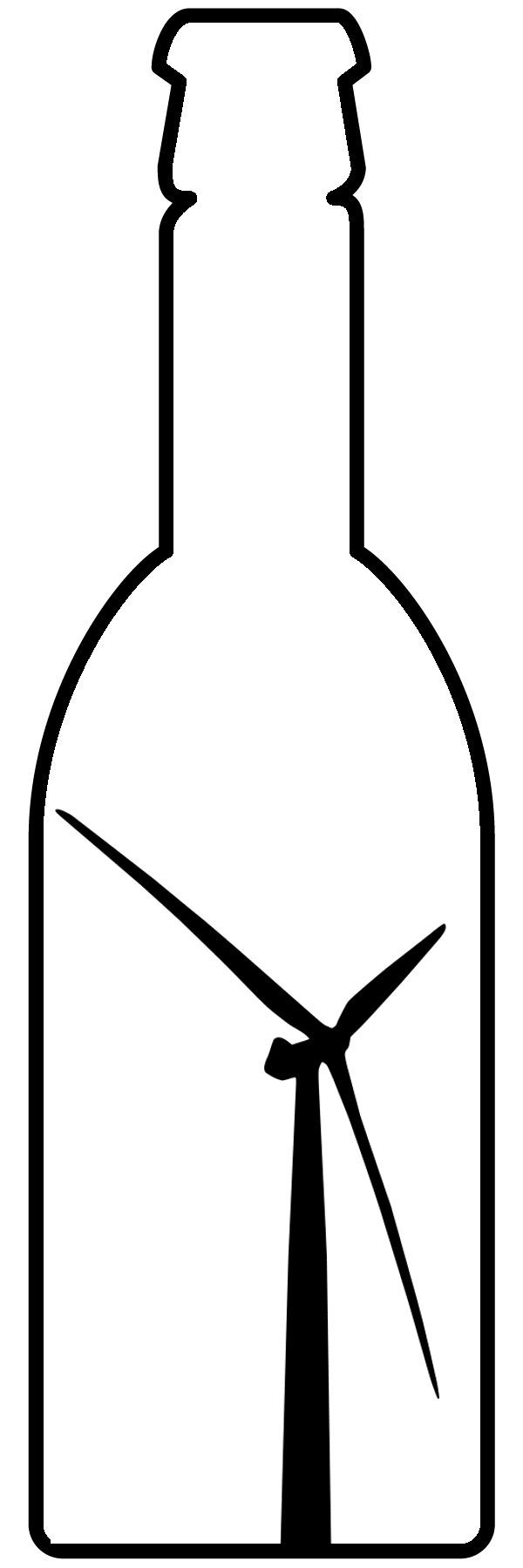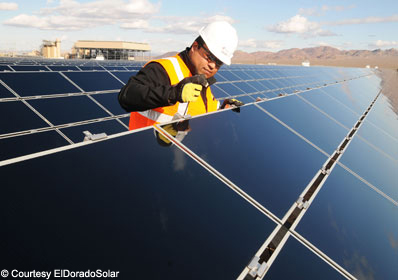

How can we get the goose out of the bottle without breaking it? It is the concept of "satori," "revelation". It is something that shakes you out of your old views and takes you to a new vision. It happens when you see something apparently impossible suddenly coming true, like the goose in the bottle suddenly appearing outside, free.
Renewables have been growing as inside a bottle so far; a bottle made of disbelief, red tape and not enough financing. It is time for a little satori in renewable energy. Renewables can hold on their own with new and more efficient technologies, in particular the CdTe thin film version which may have an EROEI of 40. With such EROEIs, we can start thinking of renewable energy as abundant and cheap. (image on the right from rhizome.org)
A few years ago, at a meeting on energy, I met a lady who turned out to be the environment minister for one of the county governments in Italy. Talking with her, I started feeling a sort of cognitive dissonance. We were using the same words: solar, wind, and the like, but with different meanings. At some point it dawned on me: she was fully convinced that renewables don't really produce any energy; that wind towers and photovoltaic plants are nice toys to make environmentalists happy but that their main purpose is to create business and transfer money from one place to another. So, she saw that her duty as environment minister was to make sure that some of the money would find its way to the goverment of her region, in exchange for the permission they gave to build the plants.
I can't really fault this lady for the way she had understood the situation; not after I have seen expensive "cash for clunkers" programs being implemented in Italy and elsewhere. If a government is willing to pay cash for destroying perfectly good cars in the name of the environment, one wouldn't be surprised if wind turbines were to turn out to be little more than souped up lava lamps. Machines that turn and turn, but produce nothing.
This is an attitude that I have often seen in politicians and the public alike: renewables are nice toys, but little more. When it is time to get serious, you need something real. You can't produce energy without burning something. You need a smokestack, somewhere, that's why you need coal, or oil, or gas. That explains another story I was told: that of the national minister of industry who was shown an electric heater (about 1 kW) powered by a 300 kW photovoltaic plant and who refused to believe what he was seeing. "Where is the trick?" he kept asking. No smokestack, no energy, apparently. You can't power the world with little blue squares facing the sun or with propellers that turn in the wind, sometimes.
Even promoters of renewables seem to see renewable energy as at best a marginal source. Most environmentalits seem to think that the right way to go is energy saving. That's the real, untapped energy source that we need to exploit. This is a respectable opinion, but I think it doesn't take into account the real potential of renewables. And that potential is truly gigantic: think of the amount of sunlight that arrives on earth everyday - you probably have heard that it is almost 10,000 times larger than the primary energy we produce today (see here ). So, what prevents us from using it? Once you start thinking about the possibilities, you may experience a little satori , an illumination where you see renewable energy suddenly breaking free out of the bottle. Renewables can provide as much energy as we need and it doesn't have to be expensive. After all, sunlight and wind are free and there is plenty of both.
But even a Zen satori has to be based on some good physics when it is about energy. And, when talking renewables, the good physics is mostly contained in the concept of EROEI - energy returned for energy invested. It is the ratio of the energy that a plant can produce over its lifetime divided by the energy needed to build it, maintain it, and dismantle it when its useful life is over. A good energy source must have an EROEI larger than one; obviously. But that is not enough; it must have an energy much larger than one if it has to provide that surplus that we need to keep up what we call "civilization".
Now, if you look at Charles Hall's balloon graph with a list of EROEIs for various sources, you'll probably think that there is not much hope for renewables. In the graph, the EROEI of PV is given as under 10 and that of wind as under 20. The graph is dominated by the blue balloon of "Oil, domestic, 1930") which is rated as having EROEI= 100. If our economy has been built on oil and if oil's EROEI is so large (or, at least it was at that time) then we can't expect that renewables could substitute oil and fossil fuels. Renewables, it seems, are a marginal source at best and surely can't give us back the good times of old.
But things move on. Charlie Hall's graph is already outdated in some points. The EROEI of renewables is increasing, it is actually shooting up. Realizing how fast that is happening was a little satori for me, not more than a few months ago.

Now, tell me if this is not enough for a good satori. An EROEI of 40? And that with a "state of the art" system? Yes, with CdTe cells that you can buy on the market! I can almost hear the objections - that I am too optimistic, that the EROEI depends on the initial assumptions, and how about intermittency, and don't you know that we passed peak tellurium? And so on. But let me discuss these objections in a note at the end of this post. For the time being, let's take this large value of the EROEI as a working hypothesis and let's see how we got there and what are the perspectives.
First of all, this high EROEI is the result of a breakthrough in thin film cells. There are many ways of making thin film cells; the advantage is that the amount of material needed is very small and that reduces the cost. The problem is that in some cases it is the manufacturing of the cells that is expensive; requiring, for instance, vacuum processing. In other cases, making the cell may be cheap, but it is the efficiency of light conversion that is low; that's the case of many kinds of organic cells. The low efficiency of the cells increases the cost of the installation (called "BOS", "balance of system") because larger areas are needed.
So far, thin film cells have been either too expensive or too inefficient (or both). However, in the past few years, CdTe (cadmium telluride) cells have reached conversion efficiencies of the order of 11% and that has led to a commercial boom all over the world. A breakthrough, indeed, compounded by further advantages of the CdTe technology: that of being less sensitive than silicon cells to high temperatures, and that of being more efficient in capturing diffuse light. First Solar , the company that makes CdTe cells, is now the second largest producer of solar cells in the world, with a yearly production corresponding to about 1.2 GW peak power. Plans have been announced for reaching 1.8 GW by 2012.
So, we aren't yet at the EROEI = 100 of oil in the 1930, but the progress in this area has been remarkable. And if PV based on CdTe can have an EROEI of 40, what prevents us from getting much higher values, using the same or other thin film PV technologies? And not just photovoltaic cells are susceptible of breakthroughs. Not long ago, I had another satori when I reviewed the situation with Airborne Wind Energy (AWE) and in particular the implementation called Kitegen. Here, we are talking of prototypes still under costruction, but the simulations are extremely promising - the EROEI could well be over 100 .
At these EROEI levels, well, the goose is really out of the bottle (and the bottle is not broken).
Of course we can't yet claim that the energy problem is solved. We may have high EROEI renewable sources, but we still have to build up the infrastructure needed to build and deploy the plants; we need to build up a "smart grid" system that can manage power production in such a way to overcome the intermittency problem; we need also to restructure our economy in such a way that it can use electric power instead of fossil fuels for such things as transportation. It can be done, but it is not at all obvious that it can be done before running out of the resources needed for doing it, that is of fossil fuels. But it is not impossible.
It is a fighting chance, but it is there.
Note:
The calculation of the EROEI depends on where exactly you take the "boundaries" of the system and that we still don't have rules on this point (see this paper by Charles Hall ). But as long as we compare different technologies then we can compare the relative EROEIs and that has a meaning if the same methodologies have been applied; which is the case here.
About PV in general, I know that we need to take into account the question of storage, but that is very often overstated and PV is not supposed to be the only technology used for energy production. PV would be embedded in a mix of different sources over large areas that would compensate each other. The concept of of "smart grid" would provide the necessary management of the energy produced and consumed.
Then, I know that the value of EROEI=40 it is obtained under rather optimistic assumptions: that the plant is located in a well irradiated area (e.g. Southern Europe or North Africa) and that it has a lifetime of 30 years. Optimistic, perhaps, but realistic as well. You CAN place these plants in Southern Europe, North Africa or Southern US and their lifetime can exceed thirty years if they are decently maintained. So, we are not talking futuristic applications - it is reality.
Then, there are other objections that one can make to CdTe technology; that it needs the rare element tellurium, that cadmium is toxic and what happens in case of fire; etc. All reasonable objections, but notice that these very problems imply that there is a tremendous stimulus to recover and recycle the materials used.
Finally, if one thin film technology can be made commercial, it is reasonable to think that there are more that can reach the same level.
References
"Life cycle assessment and energy pay-back time of advanced photovoltaic modules: CdTe and CIS compared to poly-Si", by Marco Raugei, Silvia Bargiglia and Sergio Ulgiati at Energy Volume 32, Issue 8, August 2007, Pages 1310-1318
"Update of PV energy payback times and life-cycle greenhouse gas emissions" V. Fthenakis, H.C. Kim, M. Held, M. Raugei and J. Krones, 24th European Photovoltaic Solar Energy Conference, 21-25 September 2009, Hamburg, Germany
The future of capitalism - profits and growthClothing designer finds the right fit
No comments:
Post a Comment